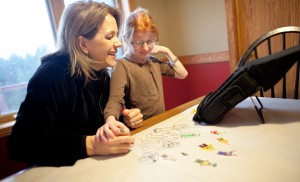Don’t mess with my kid
Features — By Ann Rivall“People listen to me more when I talk about [disabilities] because Erika is my sister,” McKenna, now 13, says.
In her winning video, images of Erika swimming and jumping on the family’s trampoline are accompanied by McKenna’s small-yet-confident voice describing Erica’s personality and their unique relationship. The 30-second commercial ends with McKenna saying, “I envision a world in which people with disabilities have a voice, just like you and me. Assistive Technology can make that happen.”
McKenna is just one in the choir of voices that is the Madison Partners for Inclusive Education. While the collective voice fights for rights for their disabled children, each member also has his or her own motivations.
For Beth Swedeen, Madison Partners for Inclusive Education isn’t just about advocating for her daughter, Cara, a high school senior at Madison West with a significant intellectual disability. It’s about making sure every student can benefit from inclusive education.
“How can we ensure that every child in Madison schools — regardless of how much their family can advocate, regardless of what the level of their disability is, regardless of what school they are able to attend because of where they live — gets a high-quality inclusive educational experience and that they’re equipped for adulthood when they leave the Madison schools?” Swedeen says.
According to John Harper, the executive director for educational services in the Madison school district, Madison schools only have a 5 percent separation rate; meaning students with disabilities are only separated if they are a serious distraction in the classroom, with nearly 90 percent of disability students at the elementary level included.
The good fight

Lisa Pugh says she wears her passion on her sleeve. Photo by Lukas Keapproth
For Beth Moss and her son, life is entirely different. Beth now serves as the vice president for the Madison School Board. Garner is a three-season athlete at James Madison Memorial High School, and the benefits of his inclusive education clearly show.
When Garner talks to his mom, he touches her shoulder or taps her hand and looks her straight in the eye while leaning forward to get her attention. When there is a lull in the conversation, he fills it with quiet descriptions of Schindler elevators. Sometimes, he cups his hand over his right ear to hear the sound of his voice.
“Now he’s used to functioning with support, so much more than he ever could have without support,” Moss says. “Now he’ll be able to have a job, and he’s planning to go to college for a couple years… He’ll have support but he will live in a dorm, he’ll go to classes, and he’ll be perfectly capable of doing that because he’s been trained to do that, he’s used to it and he knows what to do. But if that had never happened for him, he’d have to have someone following him around for the rest of his life.”
“Mom, I want to be a garbage truck man when I grow up,” Garner says.
And a few minutes later, “Mom, I want to be a bus driver for the Madison Metro when I grow up.”
“So many options,” Moss says, smiling at her son.
Although successful inclusion stories like Garner’s exist throughout the district, inclusive education is not met without opposition. In particular, parents of non-disabled students argue that including children with disabilities in general education classrooms hinders their child’s learning experience. To combat the naysayers, Udvari-Solner nods to her research findings that suggest this teaching method truly assists all students involved.
“There are beneficial effects such as increased self-esteem — students have the opportunity to be generous, altruistic, to gain a level of understanding of somebody else’s learning style…tolerance toward differences,” Udvari-Solner says. “These social measures are really critical in terms of the way we behave as human beings.”
Though Swedeen describes herself as a “rabid inclusionist,” she shies away from relying on this defense. Instead, she references studies like those conducted by Udvari-Solner.
“I do point to some of the research that shows that when kids are equipped well and the instruction is high-quality, that when kids with and without disabilities are paired together… that all kids’ grades go up,” Swedeen says. “I think that is probably more of a salient argument to present to families who think it’s one group of kids against another group of kids than to say, ‘Well, your child will learn compassion and understanding,’ and they’ll say, ‘Well, that won’t get my kid into Harvard.’”
Beth Moss, Lisa Pugh, Beth Swedeen and all the other mothers of disabled children definitely know how to put up a fight. But for them that comes with the territory of being a mother.
“Moms, we have this ‘don’t mess with my kid’ kind of attitude,” Pugh says. “I will fight to the death for my children in terms of helping them to get what I feel is fair and their right.”
Tags: Inclusive Ed, Rivall




 Digg This
Digg This Bookmark
Bookmark Stumble
Stumble